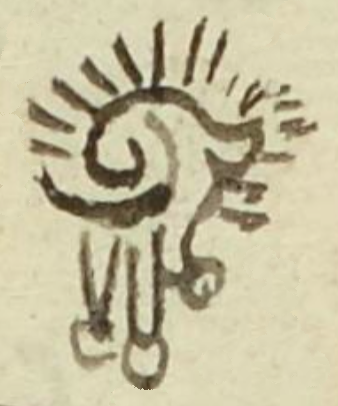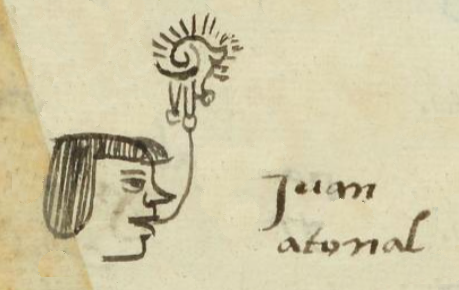Atonal (MH626v)
This black-line drawing of the compound glyph for the personal name Atonal (“Water" the day sign, or Dzawindanda in Mixtec) shows a swirling stream of water (atl) with three offshoots, each one with a droplet at the end. Water is a day sign in the 260-divinatory calendar (the tonalpohualli). On top of the water and along its sides is a series of short lines that suggest rays of sunlight (tonalli), which refers to the sun, a day, and a solar animating force.
Stephanie Wood
The rays of sunshine suggest a vibrance or a brilliance with the effect of movement. For other examples of glyphs with these same kinds of lines, see below. Additional Atonal glyphs, with various iconographic forms, also appear below.
This is likely a case where a relatively average citizen was given an illustrious calendrical name. The famous Atonal was a Mixtec ruler. According to Wikipedia, Atonaltzin (in the reverential form of the name in Nahuatl) was also called Dzawindanda by the Mixtecs. He ruled the Mixtec kingdom of Coixtlahuaca. After the first Motecuhzoma took power over Coixtlahuaca, sometime in the second half of the fifteenth century, the Nahuas executed Atonal apparently in revenge for the deaths of a large number of long distance merchants. Maarten Jansen and Gabina Aurora Pérez Jiménez (Time and the Ancestors, 2017, 337) suggest the following meaning for Atonal: "Atonal refers to a person with a calendar name that contained the day sign Water."
Stephanie Wood
Juan
atonal
Juan Atonal
Stephanie Wood
1560
Jeff Haskett-Wood
nombres de hombres, nombres de personas famosas, gobernadores, Mixtecos, calendarios, días, agua, sol, canales, tonales, fuerzas animadoras, religión indígena, tonalpohualli

a(tl), water, https://nahuatl.wired-humanities.org/content/atl
tonal(li), sun, day, personal animating force, https://nahuatl.wired-humanities.org/content/tonalli
Agua, o posiblemente, Brillo de Agua
Stephanie Wood
Matrícula de Huexotzinco, folio 626v, World Digital Library, https://www.loc.gov/resource/gdcwdl.wdl_15282/?sp=335st=image.
This manuscript is hosted by the Library of Congress and the World Digital Library; used here with the Creative Commons, “Attribution-NonCommercial-ShareAlike 3.0 License” (CC-BY-NC-SAq 3.0).











